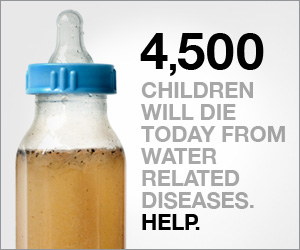![]() I have recently noticed a banner on a blog run by a fellow marketer. You can see it on your left now.
I have recently noticed a banner on a blog run by a fellow marketer. You can see it on your left now.
Each word on the banner carries an enormous power, and all of them together — a powerful emotional message. We are told that this will happen — “4,500 kids will die today.” We are not called to click on the banner, but most of us will. The message is too powerful for us to ignore it.
When we click on the banner we land on a website of charity: water — a “non-profit bringing clean and safe drinking water to people in developing nations.” It’s a great cause, and I am fully supportive of what they do. But I have a problem with that little 125×125 banner.
The approach used while creating the banner isn’t new. Talking of a campaign against abortion in his Effective Advertising: Understanding When, How, and Why Advertising Works (2004) Gerard J. Tellis wrote that images which “arose strong feelings of horror and guilt among viewers” were used in it “to win immediate converts to the cause” (p. 150).
But is such approach effective? It depends on what your end goal is.
Describing the emotional component of such tactic in his The Marketing Power of Emotion (2003) John O’Shaughnessy wrote:
Negative emotions like guilt and shame exercise greater hold that positive emotions like pride because they tend to impose themselves on the mind as they are less optional emotions that (say) joy. (p. 101)
Then he also added an important observation:
…the emotion of guilt can serve as a substitute for action as an indirect way of satisfying perceived obligations to take action without actually doing so [underlining mine].
This is problem #1 with that banner — its creators certainly don’t want the emotion itself to “serve as a substitute” of the action (be it creating awareness of the problem among others, donating to the cause, etc).
Problem #2, in my opinion, is that the wording as it is now sounds like a death sentence. While it is still likely produce the desired action, it conveys a meaning of hopelessness, on the one hand; and on the other hand, when I click it, decide to participate, and even do something, a bitter aftertaste doesn’t go away.
This same organization has a 300×250 pixels banner, which looks somewhat better (having a clear call to action on it):

But the message could still use improvement. Changing the wording into “Help prevent 4,500 child deaths every day” would have been more effective, in my opinion.
What do you think (and feel)?
I disagree. I think that the first banner is an extremely effective ad. The whole point of the campaign is to create horror, shame, and guilt because that is the method that they are using to get donations. People don’t donate to these charities because they are in a good mood, they do it because they feel guilty that anyone else is denied the basic elements of survival that we take for granted. Also, if you re-write it to take out the shock factor, it’s just not going to get as many clicks. Bottom line.
I don’t doubt they’re getting a good CTR on that one, Josh. What I do doubt, however, is that the CTR is translating into the conversions (i.e. the donations), or as high % of conversions as it could’ve been. As mentioned in my post, research shows that “the emotion of guilt can serve as a substitute for action as an indirect way of satisfying perceived obligations to take action without actually doing so”, and that is definitely not how we want the ad viewer to end up. I also stand by my second point; but I do appreciate a different opinion, anyway. Thanks for taking the time to comment.
I agree with Geno’s research that negative emotions can serve as a substitute for action. Just from my own personal experience with PETA. After donating money with a volunteer, I was then bombarded with gruesome images and sad emails and letters thereafter. I quit sending them money, stopped opening their letters and never visited their site again. The hopelessness and emotional toll was too much. Making people feel like their effort really will make a difference inspires hope, makes people feel good, and has a better chance of going viral. Bottom line in any campaign is the conversion rate. If your message is making people run the other direction, you’re not achieving their conversion.
Well said.
Thank you, Jeune. Always interesting to hear of first-hand experience.
So, do you agree or disagree, Josh?
You both make a good point, I guess I wasn’t thinking about the conversion rate of people actually donating money as much as the CTR. But now that I think about it, it does rub me the wrong way when activists use shock tactics like showing pictures of aborted fetuses on the sidewalk to get people to oppose it. It just turns me off to the cause, so I guess I’m a case in point.
Might be worth considering the effect of a ‘I am fed up with being made feel guilty’ reaction. I think that ‘You really can help because we will make sure that every little contribution will become part of something significant’ is a strong and empowering message. Inaction can result from a depressing sense of ‘it won’t make any difference’. Brian